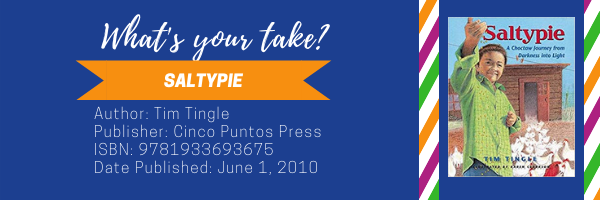By Seemi Aziz, University of Arizona, Tucson, AZ and Celeste Trimble, Celeste Trimble, St. Martin’s University, Lacey, WA
As we continue to focus on the theme of displacement and its representations in young adult and children’s literature, we turn our attention to Saltypie by Tim Tingle. Through family history of racism and displacement, as well as powerful family love and togetherness, Saltypie tells the true story of a young Choctaw boy and his grandmother. In this 2010 picturebook put out by Cinco Puntos Press, Choctaw storyteller Tim Tingle shares a story from his own family. One central concept, highlighted in the title, is that Tingle’s grandmother is blinded by a racist neighbor throwing a rock at her after they moved from Oklahoma to Texas. She regains her sight through an eye transplant much later in her life. Reviews and awards for Saltypie include ALA Notable Children’s Books, 2011, Booklist, 05/01/10, Kirkus Reviews, 04/15/10, Library Media Connection, 11/01/10, Publishers Weekly, 04/26/10, School Library Journal, 05/01/10, and Wilson’s Children, 10/01/10.

CELESTE: Honestly, my initial reaction to this book is that the afterward, “How Much Can We Tell Them,” is absolutely essential to understanding the main story. Behind the story of Mawmaw losing and then regaining her vision, there is a story of displacement, racism and trauma, and how the Choctaw people have survived.
SEEMI: I find the story shocking but disjointed and disconnected. The hate of the past coming to impact the present and future seem to be the theme. I do not think it connected directly to the displacement theme too well. Yes, it is connected to the overall theme through the lived experiences of all First Nation people who were displaced. Racism is definitely present in it and is woven into the very fabric of the book. Some things to consider would be adults not mentioning an elder’s disability until it becomes a direct concern of pouring hot tea.
CELESTE: The story does skirt around the issue of displacement, but that is connected to the notion of “saltypie” that Tingle brings up. When the child asks what a saltypie is, his father responds, “It’s a way of dealing with trouble, son. Sometimes you don’t know where the trouble comes from. You just kinda shrug it off, say saltypie. It helps you carry on.” By not explicitly addressing the topic of removal and displacement within the body of the story, I believe this is a form of saying saltypie and carrying on. Indeed, the title of the backmatter is “How much can we tell them?” in reference to the traumatic stories of displacement that are the foundation of the story but not there in so many words. The trauma of displacement is never over, whether we are talking about the Partition, or the Trail of Tears, or deportation of dreamers, or refugees in other places fleeing violence.
So, when Tingle states in the back matter, “In many ways the story of Saltypie is a continuation of this trauma of removal,” I understand that indeed it is inseparable from the story of the initial Trail of Tears in 1830, when the Choctaw Nation was forced to leave their ancestral homelands. It is inseparable from forced family separation that occurred with the boarding schooling system, that is explicitly addressed within the body of the text. And, it also makes me wonder why the family moved to Texas in 1915.
Author: Tim Tingle
Publisher: Cinco Puntos Press
ISBN: 9781933693675
Date Published: June 1, 2010
Throughout July 2019, Celeste and Seemi give their takes on books on the theme of displacements and its representations. Check back each Wednesday to follow the conversation!
- Themes: Celeste Trimble, Saltypie, Seemi Aziz, Tim Tingle
- Descriptors: Books & Resources, My Take/Your Take
